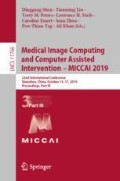Abstract
In this paper, a neural architecture search (NAS) framework is proposed for 3D medical image segmentation, to automatically optimize a neural architecture from a large design space. Our NAS framework searches the structure of each layer including neural connectivities and operation types in both of the encoder and decoder. Since optimizing over a large discrete architecture space is difficult due to high-resolution 3D medical images, a novel stochastic sampling algorithm based on a continuous relaxation is also proposed for scalable gradient based optimization. On the 3D medical image segmentation tasks with a benchmark dataset, an automatically designed architecture by the proposed NAS framework outperforms the human-designed 3D U-Net, and moreover this optimized architecture is well suited to be transferred for different tasks.
S. Kim, I. Kim and S. Lim—Contributed equally.
Access this chapter
Tax calculation will be finalised at checkout
Purchases are for personal use only
Notes
- 1.
In the decoder, before used as one of inputs of the current cell, an output of the last previous cell is summed with an output of the encoder cell at the same level.
- 2.
We set the annealing schedule as \(\tau = \max (0.001, \exp (-0.025t))\).
- 3.
We tried sampling one operation at a time, but the performance was not improved because of the use of high bias architecture and insufficient architecture variation (exploration) especially in the early stage of training.
- 4.
- 5.
DARTS [6] requires approximately 4 times more GPU memory in comparison to the SCNAS during architecture search with the same number of channels.
References
Çiçek, Ö., Abdulkadir, A., Lienkamp, S.S., Brox, T., Ronneberger, O.: 3D U-Net: learning dense volumetric segmentation from sparse annotation. In: Ourselin, S., Joskowicz, L., Sabuncu, M.R., Unal, G., Wells, W. (eds.) MICCAI 2016. LNCS, vol. 9901, pp. 424–432. Springer, Cham (2016). https://doi.org/10.1007/978-3-319-46723-8_49
Isensee, F., et al.: nnU-Net: self-adapting framework for u-net-based medical image segmentation (2018)
Jaccard, P.: The distribution of the flora in the alpine zone. New Phytol. 11(2), 37–50 (1912)
Jang, E., Gu, S., Poole, B.: Categorical reparameterization with gumbel-softmax. In: ICLR (2017)
Kayalibay, B., Jensen, G., van der Smagt, P.: CNN-based segmentation of medical imaging data. CoRR abs/1701.03056 (2017). http://arxiv.org/abs/1701.03056
Liu, H., Simonyan, K., Yang, Y.: Darts: differentiable architecture search. arXiv preprint arXiv:1806.09055 (2018)
Mortazi, A., Bagci, U.: Automatically designing CNN architectures for medical image segmentation. In: Shi, Y., Suk, H.-I., Liu, M. (eds.) MLMI 2018. LNCS, vol. 11046, pp. 98–106. Springer, Cham (2018). https://doi.org/10.1007/978-3-030-00919-9_12
Naceur, M.B., Saouli, R., Akil, M., Kachouri, R.: Fully automatic brain tumor segmentation using end-to-end incremental deep neural networks in MRI images. Comput. Methods Programs Biomed. 166, 39–49 (2018)
Oktay, O., et al.: Attention U-Net: learning where to look for the pancreas. In: MIDL (2018)
Pham, H., Guan, M.Y., Zoph, B., Le, Q.V., Dean, J.: Efficient neural architecture search via parameter sharing. In: ICML (2018)
Veit, A., Belongie, S.: Convolutional networks with adaptive inference graphs. In: Ferrari, V., Hebert, M., Sminchisescu, C., Weiss, Y. (eds.) ECCV 2018. LNCS, vol. 11205, pp. 3–18. Springer, Cham (2018). https://doi.org/10.1007/978-3-030-01246-5_1
Wichrowska, O., et al.: Learned optimizers that scale and generalize. In: ICML (2017)
Xie, S., Zheng, H., Liu, C., Lin, L.: SNAS: stochastic neural architecture search. In: ICLR (2019)
Yu, L., Yang, X., Chen, H., Qin, J., Heng, P.A.: Volumetric ConvNets with mixed residual connections for automated prostate segmentation from 3D MR images. In: AAAI (2017)
Yuan, Y., Chao, M., Lo, Y.C.: Automatic skin lesion segmentation using deep fully convolutional networks with Jaccard distance. IEEE Trans. Med. Imaging 36(9), 1876–1886 (2017)
Zoph, B., Vasudevan, V., Shlens, J., Le, Q.V.: Learning transferable architectures for scalable image recognition. In: CVPR (2018)
Acknowledgement
We thank the Kakao Brain Cloud team for supporting to efficiently use GPU clusters for large-scale experiments.
Author information
Authors and Affiliations
Corresponding author
Editor information
Editors and Affiliations
Rights and permissions
Copyright information
© 2019 Springer Nature Switzerland AG
About this paper
Cite this paper
Kim, S. et al. (2019). Scalable Neural Architecture Search for 3D Medical Image Segmentation. In: Shen, D., et al. Medical Image Computing and Computer Assisted Intervention – MICCAI 2019. MICCAI 2019. Lecture Notes in Computer Science(), vol 11766. Springer, Cham. https://doi.org/10.1007/978-3-030-32248-9_25
Download citation
DOI: https://doi.org/10.1007/978-3-030-32248-9_25
Published:
Publisher Name: Springer, Cham
Print ISBN: 978-3-030-32247-2
Online ISBN: 978-3-030-32248-9
eBook Packages: Computer ScienceComputer Science (R0)


